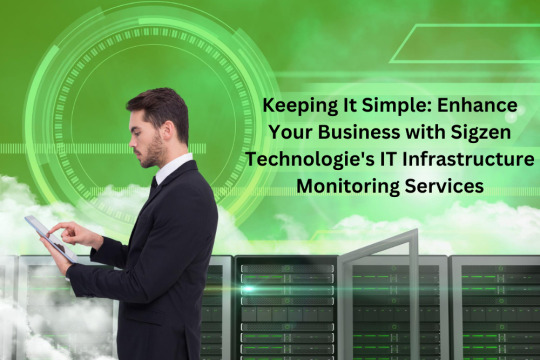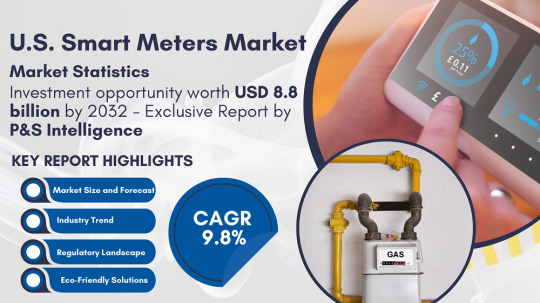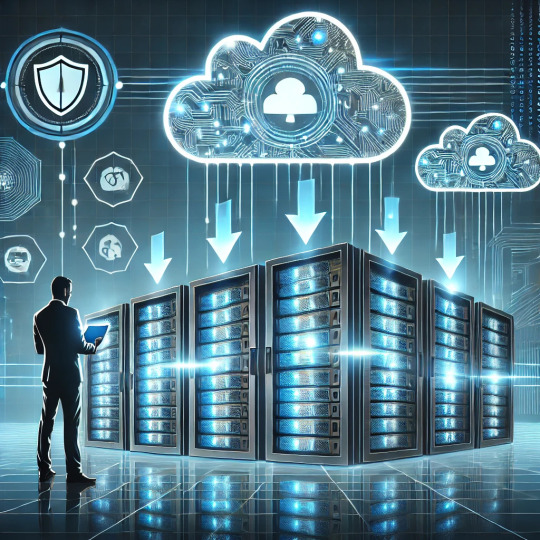#Infrastructure Monitoring
Explore tagged Tumblr posts
Text
Optimize, Analyze, Adapt: The Three Pillars of Infrastructure Monitoring
Embrace a proactive approach to infrastructure management with our comprehensive monitoring solutions. By optimizing performance, analyzing data trends, and adapting to evolving needs, you can ensure the reliability, scalability, and agility of your IT infrastructure.
2 notes
·
View notes
Text
Smart Practices for Infrastructure Monitoring Success
With technology evolving every day, businesses require strong, reliable infrastructure to run its operations. Website, internal system, and cloud application functionality rely on constant performance. That is the very reason why infrastructure monitoring is important. To measure the health, performance, use of IT assets, businesses can reduce the disruption of operations, enhance product generation, and prevent risk from turning into crises. As companies find themselves in ever more complex IT landscapes, infrastructure monitoring is critical for efficient proactive management.

Here are the key smart practices for effective infrastructure monitoring:
Define Clear Monitoring Goals
Set clear objectives first and then you are in a position to pick the right monitoring tools. What systems or applications do you have the largest effect on your organization’s operations? Do you need to evaluate system availability, response speed of service, or amount of mistakes made? Clarifying your KPIs provide you with direction into important metrics that also minimizes the chances of feeling overwhelmed by too much data.
Choose a Centralized Monitoring Solution
A centralized monitoring platform is an integration of performance data of servers, applications, databases and networks for quick retrieval. By consolidating monitoring, IT staff can identify recurring trends, connect troubles across varied systems and reduce the response lag on incidents.
Set Up Real-Time Alerts
Real-time alerting is crucial for catching problems as they happen. Configure threshold-based alerts for CPU usage, memory, disk space, and network traffic. Use escalation policies so that critical alerts are prioritized and sent to the right team members without delay.
Monitor Continuously, 24/7
Your IT systems operate around the clock—your monitoring should, too. Continuous monitoring ensures that issues are caught anytime, day or night, preventing after-hours outages from turning into costly downtime.
Track and Analyze Historical Data
Historical metrics are invaluable for trend analysis. By examining past performance data, you can identify recurring issues, plan capacity upgrades, and make informed decisions on infrastructure scaling.
Leverage Automation Wherever Possible
Automate routine monitoring tasks such as log collection, health checks, and system scans. Automation saves time, reduces manual errors, and ensures consistency across your monitoring process.
Prioritize Security in Monitoring
Infrastructure monitoring tools collect sensitive information. Secure them with role-based access controls, strong authentication, and encrypted data storage. This not only protects data but also maintains compliance with security regulations.
Regularly Review and Optimize Monitoring Strategies
As your infrastructure evolves, so should your monitoring strategy. Periodically review metrics, update thresholds, and integrate monitoring with other IT service management (ITSM) tools. This helps keep your monitoring setup aligned with business growth and technical requirements.
Ensure Scalability for Future Growth
Your monitoring system should grow with your infrastructure. Choose tools and configurations that can handle expanding workloads, cloud migrations, and hybrid environments without sacrificing visibility or performance.
Integrate with Incident Management Tools
Link monitoring tools with service desks, ticketing systems, or incident response platforms to streamline workflows. This ensures quick resolution and better coordination among IT teams.
Conclusion
Adopting smart practices for infrastructure monitoring enables businesses to detect issues early, minimize downtime, and optimize system performance. In the middle of your IT operations, infrastructure monitoring is key to creating a resilient and efficient technology environment.
0 notes
Text
What is INSAR Slope Monitoring and Why Is It Important for Geotechnical Engineering?
Monitoring slopes and detecting ground movements are important for ensuring the stability of different structures like dams roads and buildings especially in areas prone to landslides or even earthquakes. One of the most advanced technologies for monitoring slope movements is Insar Slope Monitoring. In this guide you can learn everything about it's important in the field of geotechnical engineering.
What do you need to know about the slope monitoring?
Just like infrastructure monitoring slope monitoring is actually a remote sensing technology that uses radar signals to detect and measure ground movements. The method includes the use of satellite based radar to capture images of the surface of the earth with time. By comparing all these images it's really possible for you to detect even tiny changes in the position of the ground. The satellite works by sending radar waves from a satellite to the Earth's surface and then measuring the time it takes for these waves to bounce back to the satellite. When these measurements are compared across multiple radar images you can create a detailed map of surface movement.
Why is this monitoring important?
One of the most important risks associated with slopes especially in mountainous or hilly areas is the potential for landslides. This can cause major damage to infrastructure disrupt communities and even result in loss of life. The slope monitoring provides you early warning signs by detecting ground movements long before a landslide occurs.
Well you need to know that the slope monitoring is an invaluable tool in geotechnical engineering providing accurate real time data on slope movements and helping you prevent disasters caused by landslides or slope failures.
0 notes
Text
I saw a post on Facebook that cited a single tweet from a person with seemingly no public health or epidemiology credentials as proof that H5N1 is about to be 1918 flu epidemic, part deux, and made a number of easily disprovable, google-able claims about the mortality rate of the currently spreading strains among humans.
And when someone commented that the tone seemed pretty alarmist and unhelpful. Someone else replied "WELL, IF YOU'RE SCARED IMAGINE HOW SCARED DISABLED PEOPLE ARE."
And. Okay. Well. I am worried. To the extent that disabled people can be considered a monolith, many disabled people are worried.
Please explain to me how spreading misinformation on Facebook helps anyone?
The internet was a mistake.
#yes it's quite concerning#yes it's important to monitor#ideally it's important to beef up our state and local infrastructure and our community response#it's important to protect ourselves and each other#HOWEVER#the internet was a mistake#h5n1
6 notes
·
View notes
Text
IT Infrastructure Monitoring
In the fast-paced world of technology, the backbone of any successful business lies in its IT Infrastructure monitoring.

View On WordPress
#Infrastructure Monitoring Tips#it#IT Infrastructure Monitoring#Monitoring Solutions#Monitoring Techniques#Revolutionizing IT Monitoring#Sigzen Technologies#technology
2 notes
·
View notes
Text
Exploring the Diverse Landscape of Surveys: Unveiling Different Types
Introduction Civil engineering, as a discipline, relies heavily on accurate and comprehensive data to design, plan, and construct various infrastructure projects. Surveys play a crucial role in gathering this essential information, providing engineers with the data needed to make informed decisions. There are several types of surveys in civil engineering, each serving a unique purpose. In this…

View On WordPress
#accurate measurements#as-built survey#boundary survey#civil engineering data#Civil engineering surveys#construction progress monitoring#construction survey#design accuracy#environmental monitoring#geodetic survey#global mapping#hydrographic survey#infrastructure development#infrastructure projects#land surveyor#legal boundaries#monitoring survey#project planning#property lines#structural integrity assessment#surveying in civil engineering#surveying innovations#surveying technology#topographic surveying#water body survey
2 notes
·
View notes
Text
Complexity Monitoring Device for Local Anomaly Detection in Networks
The blog provides a brief description of a Quantitative Complexity Management-based (QCM) network monitoring device. The QCM technology has been under development by Ontonix since 2005. Numerous applications have been developed which span various sectors of the industry, economics, finance and medicine. In the majority of cases, QCM solutions are used for following…

View On WordPress
#Complexity#complexity management#critical infrastructures#Extreme problems#fragility#infrastructure protection#networks#resilience#system monitoring#system of systems#vulnerability
2 notes
·
View notes
Text
How Infrastructure Monitoring Can Save Your Business Time and Money
In today’s fast-paced digital landscape, businesses rely heavily on their IT infrastructure. From servers to network devices, any downtime can lead to significant financial losses and a tarnished reputation. This is where infrastructure monitoring comes into play. By keeping a watchful eye on your IT resources, you can ensure smooth operations and unlock valuable savings for your business. Let’s explore how effective infrastructure monitoring can save you both time and money.

Understanding Infrastructure Monitoring
Infrastructure monitoring involves the continuous observation and analysis of IT resources, including servers, applications, databases, and network performance. It allows organizations to gain insights into their systems’ health and performance, enabling proactive maintenance and rapid issue resolution.
1. Early Problem Detection
One of the most significant advantages of infrastructure monitoring is the ability to detect potential issues before they escalate. By receiving real-time alerts about performance anomalies, businesses can address problems promptly. This proactive approach reduces the risk of system outages, which can be costly in terms of lost revenue and customer trust.
Example
Consider a retail company that experiences a sudden spike in traffic during a holiday sale. If their servers are not monitored effectively, they may crash, leading to lost sales and disappointed customers. With robust monitoring in place, they can scale resources on demand and maintain a seamless shopping experience.
2. Optimizing Resource Allocation
Infrastructure monitoring provides valuable insights into resource usage patterns. By analyzing data on server load, network traffic, and application performance, businesses can optimize their resource allocation. This not only improves efficiency but also reduces unnecessary expenditures on underutilized resources.
Example
A company may discover that certain servers are over-provisioned while others are strained under heavy loads. By reallocating resources based on actual usage, they can reduce costs associated with cloud services and hardware maintenance.
3. Enhancing Performance and Reliability
Monitoring tools help identify performance bottlenecks and other inefficiencies within the infrastructure. By addressing these issues, businesses can enhance the overall reliability and performance of their systems. Improved performance leads to increased employee productivity and better customer experiences, ultimately boosting the bottom line.
Example
A software company might use monitoring tools to identify a slow database query that is affecting application response times. By optimizing that query, they improve user satisfaction and reduce the number of support tickets related to performance issues.
4. Simplifying Compliance and Reporting
For many businesses, regulatory compliance is a critical aspect of operations. Infrastructure monitoring can simplify compliance by providing detailed logs and reports on system performance and security. This transparency helps organizations meet regulatory requirements and avoid potential fines, saving money in the long run.
Example
A healthcare provider needs to comply with HIPAA regulations regarding patient data security. By using monitoring tools that track access to sensitive information, they can quickly generate compliance reports and demonstrate adherence to regulations.
5. Reducing Operational Costs
By implementing infrastructure monitoring, businesses can significantly reduce operational costs associated with IT management. Automated monitoring tools minimize the need for manual checks, allowing IT teams to focus on strategic initiatives rather than routine maintenance. This shift not only saves time but also allows for more efficient use of human resources.
Example
An organization that previously required a dedicated team for server monitoring can now automate these tasks, allowing that team to concentrate on innovative projects that drive growth.
Conclusion
In an era where every second counts and every dollar matters, investing in infrastructure monitoring can yield substantial returns for businesses. By detecting problems early, optimizing resource usage, enhancing performance, simplifying compliance, and reducing operational costs, organizations can save both time and money. Embracing robust monitoring solutions not only safeguards your IT infrastructure but also positions your business for long-term success. Don’t wait for issues to arise—take control of your infrastructure today and reap the benefits tomorrow.
1 note
·
View note
Text
📊 Piezoelectric Pressure Sensors Market Set to Reach $6.0 Billion by 2035, Driven by Automotive & Healthcare Innovations
The Piezoelectric Pressure Sensors Market is projected to grow from $2.9 billion in 2024 to $6.0 billion by 2035, with a CAGR of 6.9% during the period from 2024 to 2035.
Detailed Analysis - https://datastringconsulting.com/industry-analysis/piezoelectric-pressure-sensors-market-research-report
These sensors are essential in various applications including automotive, healthcare, aerospace & defense, and oil & gas. This report identifies key growth and revenue expansion opportunities across technology types, applications, output, structure, and product types, alongside detailed revenue forecasts.
🏅 Market Leadership & Competitive Landscape
The Piezoelectric Pressure Sensors market is competitive, with leading players such as:
PCB Piezotronics
Honeywell International Inc.
Kistler Instrumente AG
Dytran Instruments Inc.
TE Connectivity
Sensata Technologies Inc.
Siemens AG
Endevco Corporation
RION Co. Ltd
Metrix Instrument Co. LLC
ASC Sensors
Meggitt Sensing Systems
These industry leaders drive market expansion by focusing on automotive applications, advanced healthcare monitoring, and integration with smart devices.
🚀 Key Growth Drivers & Opportunities
Several key trends are expected to propel growth in the Piezoelectric Pressure Sensors market, including:
Enhanced automotive applications, particularly in electric vehicles (EVs) and autonomous driving systems
Smart city infrastructure development, where sensors are critical for various monitoring and control systems
Advancements in healthcare monitoring systems, driving demand for highly accurate and reliable sensors for wearables and medical diagnostics
Integration into smart devices and Internet of Things (IoT) applications, expanding market opportunities across industries
Key regions, such as the U.S., China, Japan, Germany, and South Korea, are expected to remain major demand hubs, offering lucrative opportunities.
🌍 Regional Shifts & Evolving Supply Chains
The North America and Europe regions are the most active in the Piezoelectric Pressure Sensors market, driven by high demand in automotive and healthcare sectors. However, challenges such as:
High manufacturing costs
Technical limitations in sensor integration and calibration
are influencing market dynamics. As a result, the supply chain, from raw material procurement and component manufacturing to assembly and integration, is expected to evolve.
Emerging markets, such as India, Brazil, and South Africa, present significant opportunities for revenue diversification and TAM expansion, as demand for piezoelectric sensors grows in these regions.
🧠 About DataString Consulting
DataString Consulting is a premier provider of market research and business intelligence solutions, serving both B2B and B2C markets. Our team of industry experts provides bespoke market research to meet specific business objectives, backed by over 30 years of combined experience in strategy consulting, market analysis, and opportunity assessments.
Our services include:
Custom Market Research Reports
Strategic Consulting for market penetration
Opportunity Assessments for targeted growth
Market Forecasting and Trend Analysis
#Piezoelectric Pressure Sensors Market#Automotive Pressure Sensors#Healthcare Monitoring Sensors#Smart City Infrastructure#Advanced Pressure Sensors#Electric Vehicle Sensors#IoT Pressure Sensors#Industrial Pressure Sensors#Sensors for Aerospace & Defense#Global Sensor Market Forecast#Emerging Markets for Pressure Sensors
0 notes
Text
Beyond the Buzz: How IoT Redefines Business Operations

Moving from Hype to Reality
IoT has moved from being a futuristic idea to a practical solution that businesses use daily to improve operations and achieve sustainable growth. Though much of the discussion around IoT is about its potential, the real value that it presents is in how companies can use the technology to solve real-world problems.
Today, IoT is no longer a buzzword; it’s a necessity for any business looking to remain competitive and agile in a dynamic global environment. With its power to integrate devices, data, and processes, IoT helps businesses achieve efficiencies, improve customer satisfaction, and create new revenue streams. In this blog post, we explore how IoT is changing business operations across industries and what companies need to do to maximize its potential.
How Tudip Technologies Redefines IoT Solutions
Tudip Technologies empowers businesses with IoT solutions that tackle complex operational challenges and drive measurable outcomes.
Our Specialized Approach:
Edge Computing Integration: Enabling faster data processing closer to devices for real-time responsiveness.
IoT Ecosystem Design: Creating scalable ecosystems that adapt to changing business needs.
Sustainability-Focused Solutions: Tailoring IoT frameworks that align with environmental goals.
Example: Tudip partnered with a logistics provider to implement IoT-powered edge analytics, reducing data processing times by 60% and improving delivery accuracy across global operations.
Key Takeaways: Turning IoT Into Operational Strength
Invest in Scalable Solutions: Ensure your IoT systems can grow alongside your business needs.
Prioritize Security: Robust cybersecurity measures arToday, IoT is no longer a buzzword; it’s a necessity for any business looking to remain competitive and agile in a dynamic global environment. With its power to integrate devices, data, and processes, IoT helps businesses achieve efficiencies, improve customer satisfaction, and create new revenue streams. In this blog post, we explore how IoT is changing business operations across industries and what companies need to do to maximize its potential.
Redefining Operational Efficiency with IoT
1. Predictive Analytics: Smarter Urban Operations with IoT
IoT is revolutionizing energy management by integrating renewable energy sources into business operations. Smart systems analyze usage patterns and adjust power drawn from solar, wind, or traditional grids in real time.
Optimized Renewable Usage: IoT ensures renewable energy is used efficiently by monitoring supply-demand gaps.
Grid Stability: Balances energy loads to prevent outages during peak hours.
Sustainability Goals: Helps businesses achieve net-zero emissions by prioritizing clean energy consumption.
Example: A technology campus integrated IoT in optimizing its solar energy consumption and reduced dependence on traditional grids by 40%, with a significant reduction in operational costs
2. Energy Management: Advancing Renewable Solutions
Predictive analytics powered by IoT is transforming urban infrastructure. Cities can now monitor critical assets like bridges, roads, and utilities in real time, ensuring timely maintenance and preventing costly failures.
Public Safety: Early detection of infrastructure stress minimizes risks to citizens.
Cost Efficiency: Avoiding large-scale repairs reduces budget overruns for municipalities.
Sustainability: Proactive maintenance extends the lifespan of assets, reducing waste.
3. Automation Excellence: Better Disaster Response Logistics
IoT-driven automation is transforming how disaster response occurs—getting aid to where it is needed, faster and more efficiently.
Real-Time Inventory Management: Monitors relief inventory and ensures its proper distribution to areas of greatest need.
Smart Transportation: Optimizes routes for rescue and supply vehicles during crises.
Collaboration Across Agencies: IoT systems enable seamless communication between response teams.
Example:In a recent hurricane, one global aid organization leveraged IoT-connected drones to survey damage and automate the delivery of supplies, resulting in a 50% faster response time.
Overcoming Common IoT Challenges
1. Integration of IoT with Existing Systems
One of the biggest hurdles businesses face is integrating IoT solutions with legacy systems. Compatibility issues can hinder seamless data exchange and functionality. Solution: Use a flexible IoT platform with built-in interoperability; make sure it provides APIs for smooth integration. Careful planning and phased implementation may also reduce disruptions to a minimum.
2. Data Security and Privacy
IoT ecosystems are all about continuous data gathering and transmission, which increases exposure to cyber threats. The security of sensitive information is the foundation of trust with stakeholders.
Solution: Implement robust encryption protocols, regularly update security measures, and educate employees on cybersecurity best practices.
3. Adapting to Rapid Technological Changes
The rapid rate of innovation in IoT can make it challenging for businesses to adapt to new developments and keep their systems current. Solution: Collaborate with technology providers that offer scalable solutions and ongoing support to adapt to emerging trends without overhauling existing systems.
How IoT Drives Operational Transformation
1. Enhancing Decision-Making with Real-Time Insights
IoT provides companies with real-time data that enables informed decision-making. Whether it is revising supply chain strategies or optimizing production schedules, IoT ensures that companies can act quickly and confidently.
Dynamic Adaptability: Businesses can change their strategies according to up-to-date information and stay responsive to market demand.
Improved Collaboration: IoT systems enable better communication across departments, enabling coordinated efforts.
2. Creating Value Through Customization
IoT’s ability to collect granular data allows businesses to tailor their offerings and services to meet specific customer needs. Personalization not only enhances user experience but also builds stronger customer relationships.
e non-negotiable in today’s interconnected world.
Focus on Outcomes: Use IoT to achieve specific goals, whether it’s reducing costs, enhancing customer satisfaction, or achieving sustainability targets.
Conclusion: Moving Beyond the Buzz
IoT has evolved into an indispensable solution, reshaping how businesses optimize operations and achieve sustainable growth. By addressing real-world challenges and delivering actionable insights, IoT enables companies to stay competitive and adaptive.
To fully realize the benefits of IoT, businesses must focus on integrating flexible solutions, safeguarding data, and aligning technology with strategic objectives. With the right approach, IoT becomes more than a technological innovation—it becomes a cornerstone of operational excellence and sustainable growth.
Click the link below to learn more about the blog Beyond the Buzz: How IoT Redefines Business Operations
https://tudip.com/blog-post/beyond-the-buzz-how-iot-redefines-business-operations/
#Tudip#IoT#Internet of Things#business operations#predictive analytics#automation#real-time data#edge computing#smart infrastructure#energy management#renewable energy#sustainability#operational efficiency#cybersecurity#data security#interoperability#digital transformation#scalability#AI-driven insights#machine learning#supply chain optimization#disaster response#smart cities#industrial IoT#connected devices#enterprise IoT#cloud computing#IoT platforms#remote monitoring#predictive maintenance
0 notes
Text
U.S. Smart Meters Market Set for Rapid Growth Amid Rising Energy Efficiency Initiatives
Introduction The U.S. smart meters market is experiencing significant expansion, driven by increasing demand for energy efficiency, grid modernization, and government initiatives supporting smart grid development. With a growing emphasis on reducing energy consumption and integrating renewable energy sources, smart meters are becoming a crucial component of the country’s power…

View On WordPress
#advanced metering infrastructure#energy efficiency#real-time energy monitoring#smart grid technology#U.S. smart meters market#utility management
0 notes
Text
#Network Performance Monitoring Market#Network Monitoring Solutions#Market Research Report#IT Infrastructure Monitoring#Network Performance Management#Cloud Network Monitoring#Network Optimization Tools#Market Size and Forecast#Network Security and Performance#Real-Time Network Monitoring#Competitive Landscape#Network Analytics and Insights#Emerging Trends in Network Monitoring#Software-Defined Networking (SDN) Monitoring#Network Troubleshooting Tools#Global Network Monitoring Market#AI in Network Performance Monitoring#Network Performance for Enterprises#5G Network Monitoring#Network Health and Diagnostics
0 notes
Text
I love it when I'm doing a headless setup of a raspberry pi and I need the mac address to register on the wifi, but I can only get the mac address once I've ssh-ed onto it from the same network, whihc requires registering onto the netwoRK WITH THE MAC ADDRESS--
#strawberry debug#I'm at the point where I'm just gonna borrow a keyboard and monitor from the shop and NOT set it up headless#love linux#hate our IT infrastructure
0 notes
Text
Cloud Migration Service: A Seamless Transition to the Cloud
In today's digital landscape, businesses are increasingly adopting cloud solutions to enhance scalability, flexibility, and cost efficiency. A Cloud Migration Service plays a crucial role in ensuring a smooth transition from on-premises infrastructure to cloud environments, minimizing risks and maximizing operational benefits.
What is a Cloud Migration Service?
A Cloud Migration Service involves the process of transferring data, applications, and IT resources from traditional systems to a cloud-based infrastructure. These services provide businesses with the necessary tools, strategies, and expertise to migrate efficiently while maintaining security and compliance.

Benefits of Cloud Migration Services
1. Enhanced Scalability
With cloud solutions, businesses can scale resources up or down based on demand, reducing unnecessary costs and ensuring optimal performance.
2. Cost Efficiency
Cloud migration eliminates the need for expensive on-premises hardware and maintenance, enabling businesses to pay only for what they use.
3. Improved Security
Leading cloud providers implement robust security measures, including encryption, access controls, and compliance frameworks, to protect sensitive business data.
4. Disaster Recovery and Business Continuity
Cloud migration ensures data redundancy and quick recovery solutions, minimizing downtime and enhancing business resilience.
Steps Involved in a Cloud Migration Service
1. Assessment and Planning
A thorough evaluation of existing IT infrastructure helps identify workloads best suited for migration and develop a strategic roadmap.
2. Selecting the Right Cloud Model
Organizations can choose from Public, Private, Hybrid, or Multi-Cloud environments based on their business needs.
3. Executing the Migration
A phased migration approach minimizes disruptions, ensuring a smooth transition of applications and data.
4. Testing and Optimization
Post-migration testing is crucial to ensure performance, security, and compliance are maintained in the new cloud environment.
Overcoming Common Cloud Migration Challenges
Data Security Risks: Implementing encryption and access controls.
Application Downtime: Adopting a phased or hybrid migration strategy.
Cost Management: Utilizing cloud cost optimization tools.
Compatibility Issues: Assessing and refactoring applications for cloud readiness.
Choosing the Right Cloud Migration Service Provider
When selecting a Cloud Migration Service provider, businesses should consider:
Expertise in cloud platforms like AWS, Azure, or Google Cloud.
Security and compliance certifications.
Scalability options and 24/7 support.
Conclusion
Migrating to the cloud can be a game-changer for businesses looking to innovate and grow. A professional Cloud Migration Service ensures a hassle-free transition, enhanced security, and cost-efficient operations. With the right strategy and expert guidance, organizations can unlock the full potential of cloud computing for a competitive edge in the digital era.
#Cloud Migration service#Cloud Migration and Modernization service#Infrastructure as a Service (IaaS)#Cloud Infrastructure automation and monitoring#Serverless Computing#Disaster Recovery automation service
1 note
·
View note
Text
Understanding the Importance of Water Utility Surveys
Water is a fundamental resource that sustains life, and the infrastructure supporting its supply and distribution is a critical component of urban and rural development. A water utility survey plays a pivotal role in ensuring the efficient and sustainable management of water resources.
Learn more at https://www.cyberswift.com/blog/water-utility-solution-detailed-overview/

#3D mapping for water utilities#Digital mapping for water utilities#GIS-based water utility mapping#Hydrographic utility surveys#Remote sensing for water pipelines#Surveying for water utility systems#Underground water pipeline surveys#Utility mapping for water projects#Water distribution network survey#Water distribution system assessment#Water infrastructure surveys#Water leakage detection surveys#Water pipeline mapping#Water pipeline monitoring solutions#Water supply network survey#Water utility asset management#Water utility inspection surveys#Water utility network monitoring#Water utility survey services
1 note
·
View note
Text

Gold Standard Service Founded on the Golden Rule
Auxiom is your trusted partner on your technology journey, guided by the Golden Rule.
We provide IT and Cybersecurity Services and Support for businesses, organizations, and State and Local Government and educational institutions (SLED).
What do we mean by "Outsmart Chaos"? We know that for every one problem that gets solved in the world of IT, there always seems to be several more threats. We work to stay ahead of them all with a smarter, more proactive approach.
Managed IT Managing every aspect of IT is incredibly complex, so hiring the right IT partner is critical to the success of your business.
Cybersecurity Protecting your assets, from servers all the way to individual files, is a multi-layered and potentially complicated task.
IT Projects & Consulting Make every IT investment count. Auxiom works with you to plan, design, and implement IT projects to meet your needs.
Auxiom is an E-Rate Certified service provider.
#software#servers#securityconsulting#MANAGEDSERVICES#ITServices#ITSecurity#ITHardware#IT Department monitoring#infrastructure#cybersecurity#Consulting#BusinessContinuityServices
0 notes